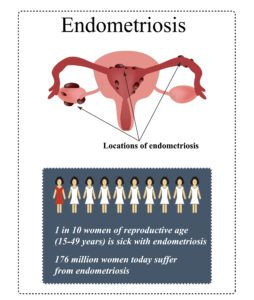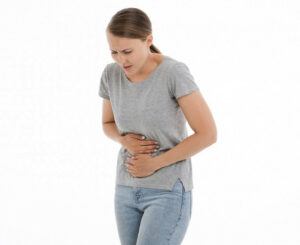All About Endometriosis: Symptoms, Causes, and Treatment Options
 Endometriosis is a common and often challenging condition that is experienced by many women today.
Endometriosis is a common and often challenging condition that is experienced by many women today.
Here we will explore what endometriosis is, the symptoms involved, underlying causes, and treatment options.
If you are personally experiencing endometriosis and the symptoms that can come along with it, I truly empathize with you. This can be an extremely difficult condition to experience and often requires a multifactorial approach to healing.
What Is Endometriosis?
Endometriosis is a condition in which the tissue that normally lines the uterus, called the endometrium, grows outside of the uterus in various locations within the abdomen and pelvis such as on the ovaries, the fallopian tubes, and the intestines.
Additional locations within the pelvic region can include the exterior surface of the uterus, lining of the pelvic cavity, posterior cul-de-sac, anterior cul-de-sac, and on the rectum, vagina, vulva, cervix, or bladder. In some cases, the tissue can also be found in the upper abdomen such as on the diaphragm. This is referred to as diaphragmatic endometriosis.
This tissue that is found outside of the uterus behaves within the body just as the normal intrauterine tissue does. With each menstrual cycle, it thickens, breaks down, and bleeds. However, because it is not located within the uterus it has no avenue by which to exit the body and becomes trapped.
This then leads to inflammation and swelling of the tissues at and around the affected areas. This can also cause severe pain.
In some cases, cysts called endometriomas can develop on the ovaries. This is when blood becomes embedded within the ovarian tissue and forms a blister that is surrounded by a fibrous cyst.
An additional complication involves the possible development of adhesions on irritated tissues. Adhesions are locations of fibrous tissue that can cause nearby organs and tissues to fuse together. This can cause further pain and discomfort, as well as altering the proper function of those organs.
Endometriosis is common, with an estimated 1 in 10 women between the ages of 15 – 49 being impacted.
Diagnosis of endometriosis can be tricky, as it is often mistaken for other conditions. It is said that most women go around 7 to 10 years before they receive a proper diagnosis.
It is difficult to accurately locate the tissue via non-invasive scans such as ultrasounds, CT scans, and MRI scans, although these are sometimes used as part of the diagnostic process.
Diagnosis is usually based upon medical history, symptom presentation, pelvic exam, and sometimes the aforementioned non-invasive scans, however the only definitive way to diagnose endometriosis at this time is laparoscopic surgery. This is explained further below.
Symptoms
The symptoms of endometriosis are varied and can manifest differently from woman to woman. Symptoms can include:
- Abdominal pain – can be extremely severe
- Additional pain – in the back, shoulders, all around the pelvic region, and elsewhere
- Exacerbation of pain with urination, bowel movements, or during sexual intercourse
- Nausea
- Vomiting
- Menstrual irregularities
- Heavy periods
- Spotting in between periods
- Severe menstrual cramping
- Fatigue
- Water retention
- Bloating and abdominal fullness
- Constipation
- Diarrhea
- Digestive upset
- Dizziness
- Headaches and migraines
- Anxiety
- Depression
- Difficulty conceiving
- More
Some women do not experience any symptoms and others experience many. Some symptoms can be constant and others can arise when there is a “flare-up.”
Every woman is different, yet endometriosis often involves “flare-ups,” which are periods of time when the symptoms dramatically increase in severity. The times when this happens can be around the time of your menstrual period or they can arise at other times as well.
For me, this involves extreme nausea which often leads to vomiting, level 10 excruciating abdominal pain, and dizziness.
“Flare-ups” can last for long periods of time, sometimes days to weeks in severe cases.
Endometriosis Pain
One of, if not the most notable symptom of endometriosis is pain. The pain associated with this condition can be a truly harrowing experience to go through.
The form of pain experienced is not isolated to worsened menstrual cramping, but often also includes stabbing, piercing, pulsing, and/or throbbing abdominal pain. Again, each woman is a bit different.
The specific locations of the pain depend on where the uterine tissue has specifically grown, and if fusions or cysts have developed as well.
An interesting characteristic of endometriosis pain is that the severity of pain does not always correlate with the severity of the condition. A mild case may involve severe pain and a severe case may involve little to no pain.
Then of course severe cases can cause severe pain.
The pain can also radiate through the shoulders, into the back, down the buttocks, and down the thighs.
The pain can be so incredibly intense it is almost like an out-of-body experience. For me, the pain can best be described as a stabbing abdominal pain that pulses in severity. It is absolutely crippling, blinding pain that is by far the worst pain I have ever felt in my life.
When it is that severe, it is nearly impossible to walk, and moving at all tends to worsen the pain.
Underlying Causes
While the science surrounding this topic is certainly still ongoing, there are several very likely underlying causes of endometriosis. These include:
- Estrogen Dominance:
Estrogen dominance is extremely common today and is one of the core underlying causes of many sex hormone/reproductive conditions and imbalances.
This is essentially an imbalance between the 2 primary female sex hormones, estrogen and progesterone.
Estrogen and progesterone levels rise and fall according to the phases of the menstrual cycle (menstruation, follicular,  ovulation, and luteal). Each performs designated important tasks throughout the body.
ovulation, and luteal). Each performs designated important tasks throughout the body.
When estrogen dominance develops, which is a high estrogen level in relation to progesterone (not necessarily a “high” estrogen level, but a higher level than is appropriate in relation to one’s progesterone levels), many symptoms and sex hormone conditions can manifest.
There must be a balanced ratio between estrogen and progesterone for optimal health.
Estrogen dominance can cause a slew of hormone imbalance symptoms including weight gain, chronic fatigue, bloating and water retention, brain fog, hair loss, acne and skin irritation, insomnia, anxiety, depression, low libido, difficulty conceiving, uterine fibroids, heavy periods, breast tenderness, and many more.
Estrogen dominance can be caused by:
-
- The birth control pill
- Xenoestrogens from plastics, cosmetics, conventional cleaners, tap water, food additives, and more (these are synthetic chemicals that mimic the effects of estrogen in the body)
- Mineral imbalance, especially Copper Toxicity
- Phytoestrogens such as soy (these are natural chemicals found in plants that mimic the effects of estrogen in the body)
- Biotoxin Illness from mold exposure and/or Lyme
- Chronic stress and/or trauma
- Obesity
- Poor liver function
- Gut imbalance
- Expressive gene variants that limit proper liver detoxification and/or impact estrogen metabolism
A key link between estrogen dominance and the development of endometriosis, is that estrogen is responsible for triggering/stimulating the thickening of the uterine lining in preparation for menstruation. If there are higher levels of estrogen in the body due to estrogen dominance, this stimulation will occur to a higher extent than is needed, resulting in the growth of endometrial tissue outside of the uterus.
Endometriosis is also said to be “estrogen dependent.”
- Additional Inflammatory Conditions/Immune System Conditions and Dysfunction:
Endometriosis is an inflammatory condition in large part because the shedding endometrial tissue causes an inflammatory response by the body. This is why endometriosis is so painful.
Therefore, any condition that is also signaling a chronic inflammatory response within the body, will contribute to and worsen the development of endometriosis.
For example, Biotoxin Illness is a chronic systemic inflammatory condition that can contribute to the development of endometriosis in 2 main ways. It can specifically raise estrogen levels, contributing to estrogen dominance and subsequently endometriosis.
It also puts the body in a chronic inflammatory state in which the immune system is chronically activated and chronically signaling an inflammatory response. This will contribute to the development of and worsen additional imbalances such as endometriosis.
- Retrograde Menstruation:
This is when menstrual blood, which contains endometrial cells, flows back up through the fallopian tubes and peritoneum into one’s pelvic cavity instead of exiting the body via the cervix. These cells can then adhere to various organs and continue to grow.
Most women can experience retrograde menstruation at some point, but it is theorized that this can contribute to the development of endometriosis in women who have higher volumes of menstrual blood flowing upward, and hence higher volumes of endometrial cells/tissue flowing into the pelvic cavity.
Treatment Options
Treating endometriosis via natural healthcare will address the underlying causes in addition to managing the symptoms as opposed to solely treating the symptoms.
Click here for a full article on endometriosis treatment.
In Closing…
Endometriosis can be an extremely challenging condition to experience, yet implementing a multifactorial approach is very effective at managing symptoms and treating the underlying causes.
My heart truly goes out to you if you or someone you love is currently going through the challenges associated with endometriosis. You’re so strong and you’ll get through this.
I’m sending you strength, peace, and healing…you’ve got this 💜.
REFERENCES